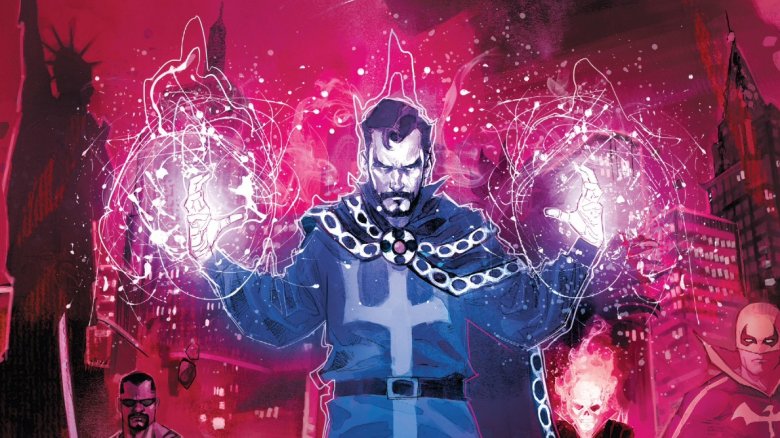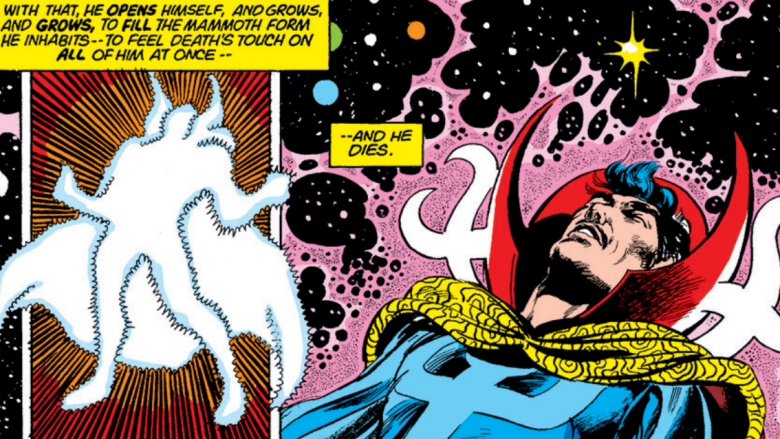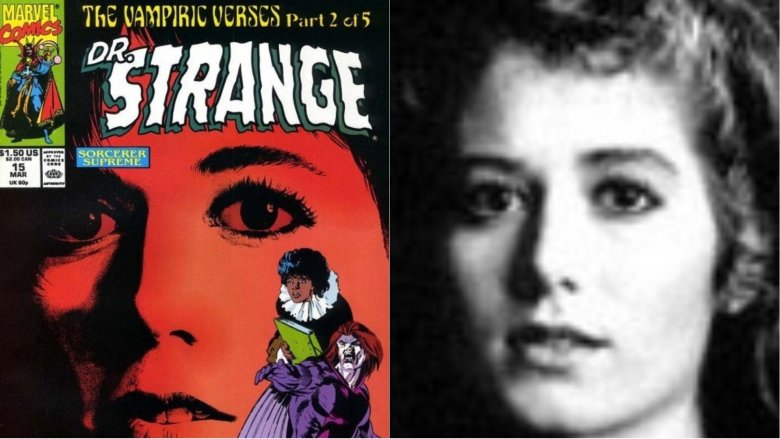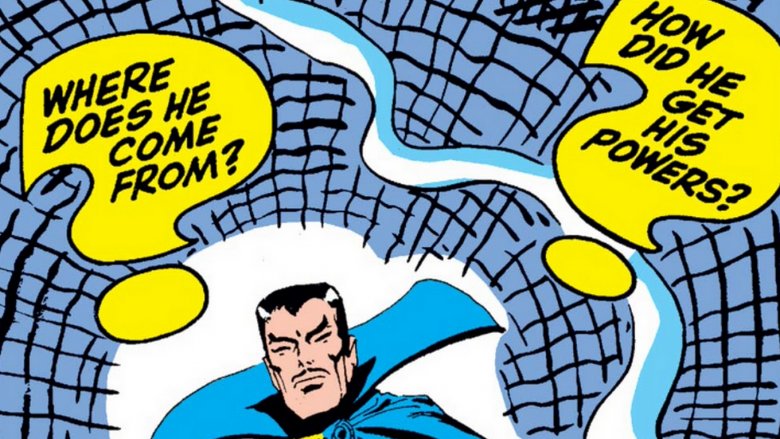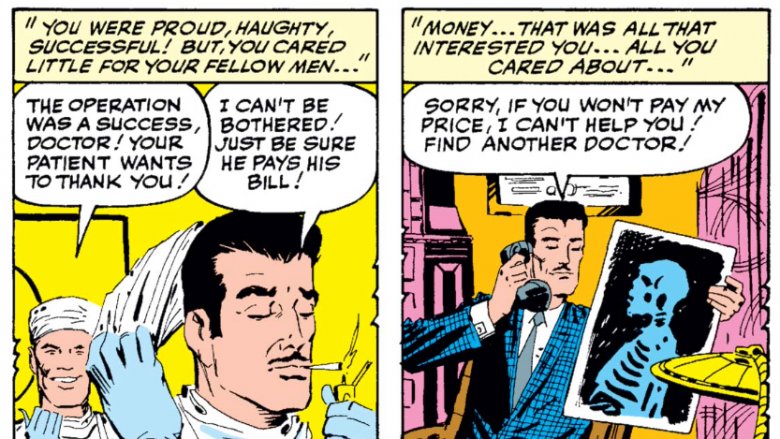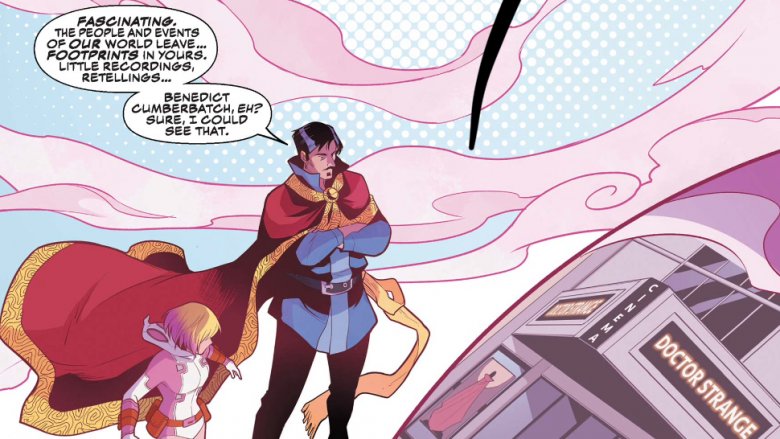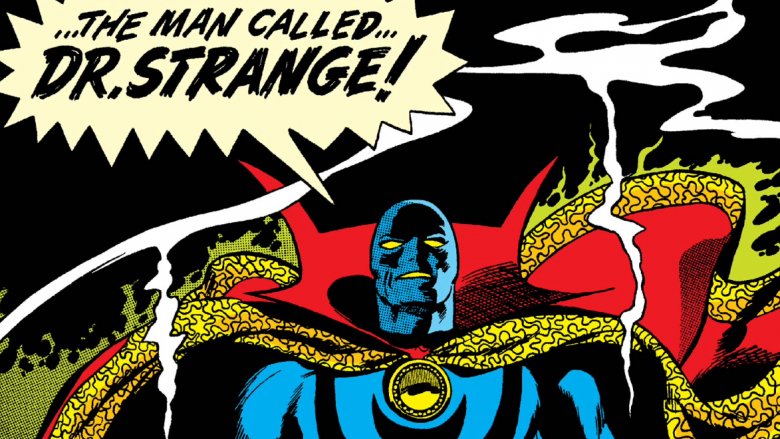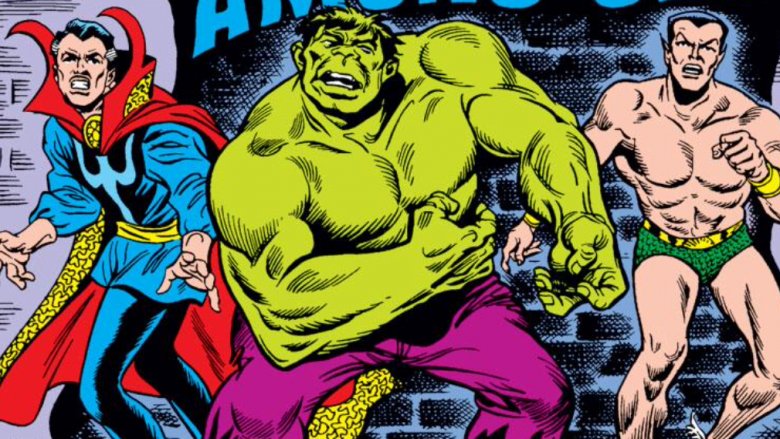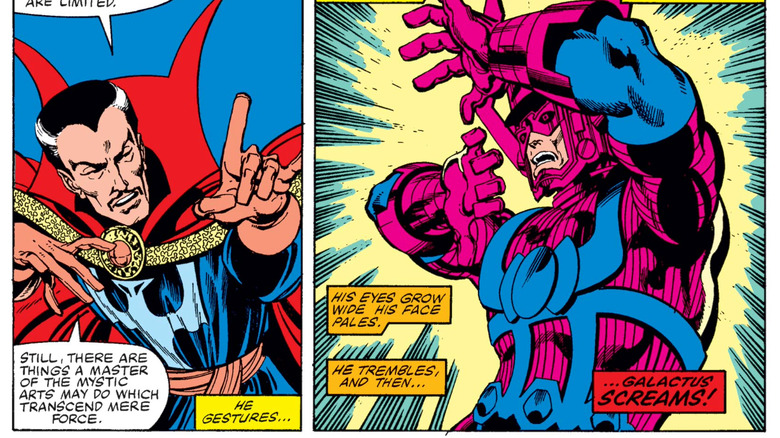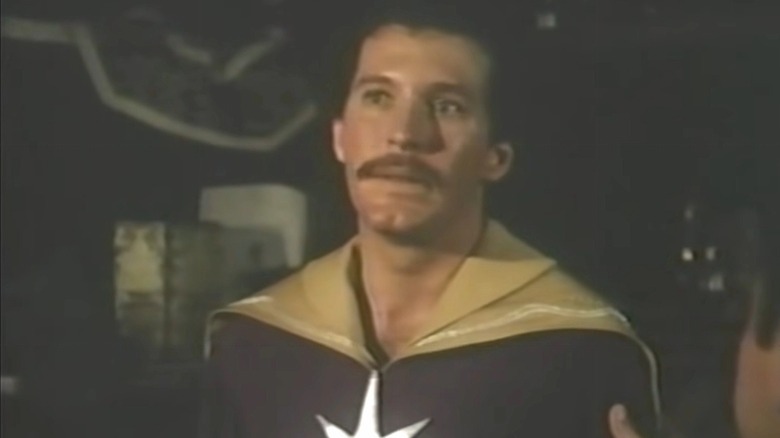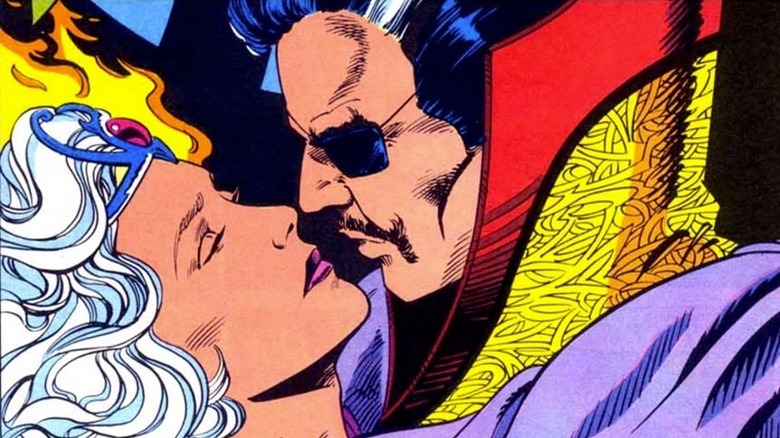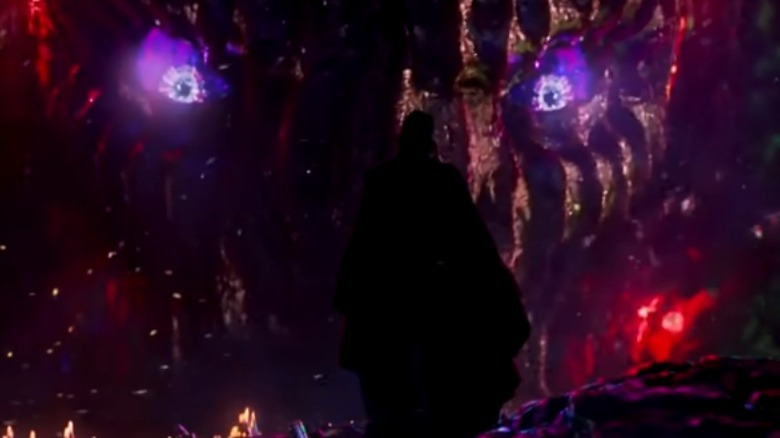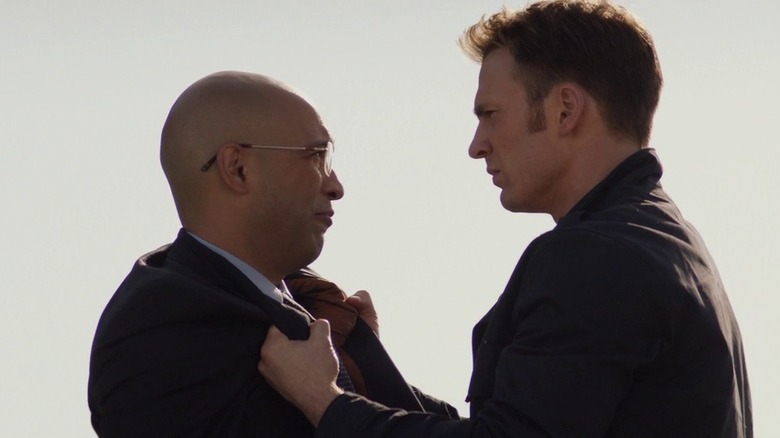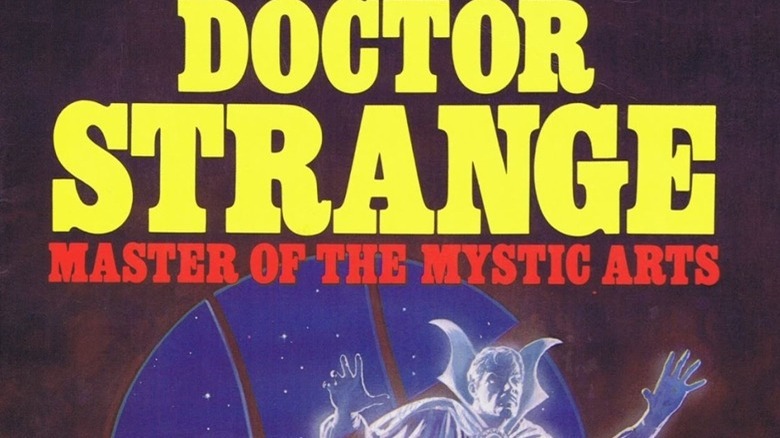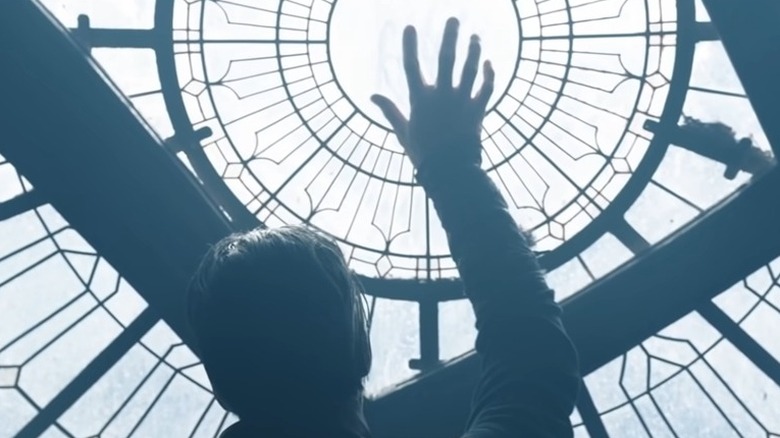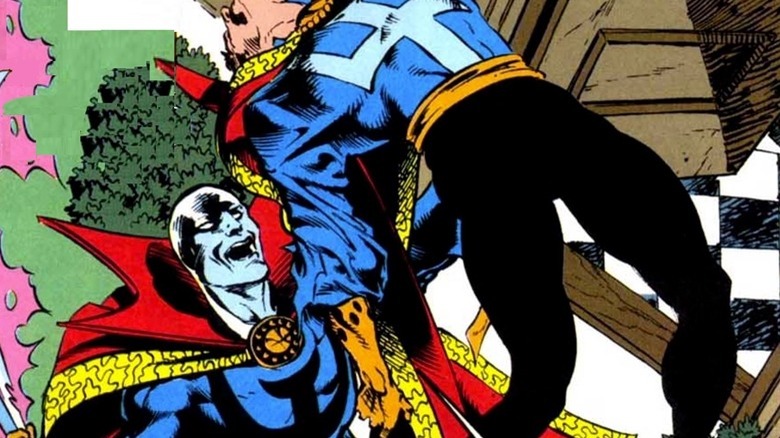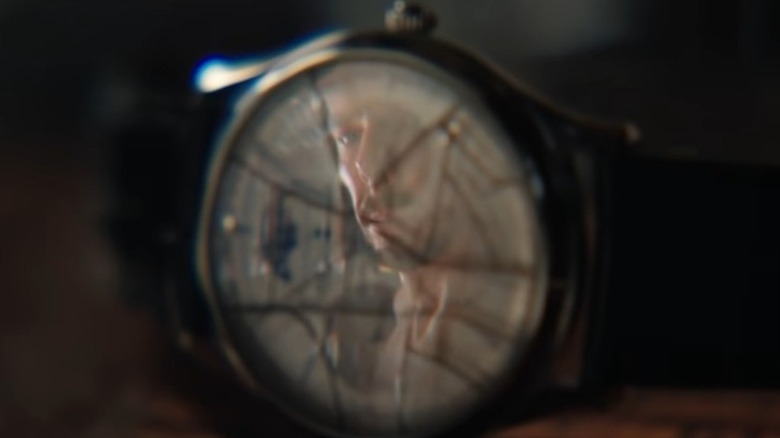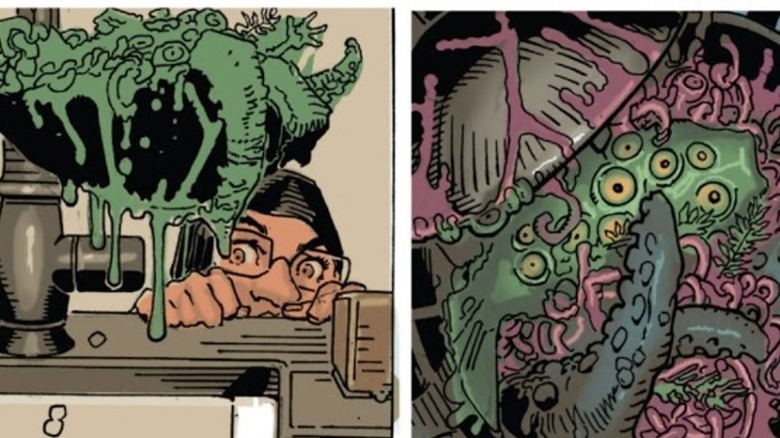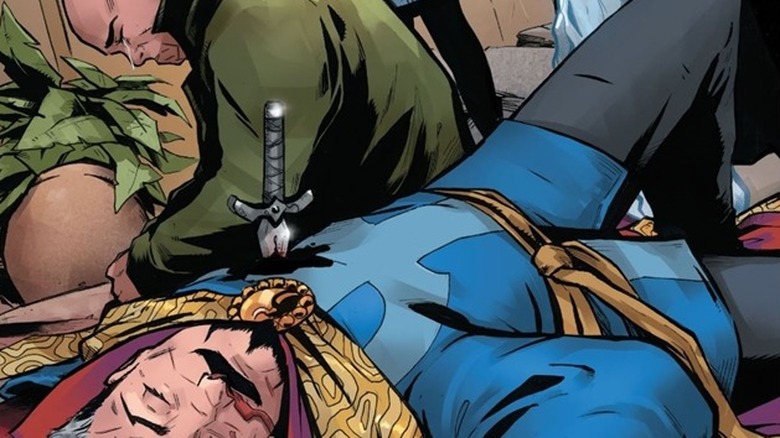The Untold Truth Of Doctor Strange
Doctor Strange inhabits a unique place in the Marvel Universe. If it's accurate to call him a superhero, then he's a very specific kind of superhero: He doesn't patrol the city for muggers or bank robbers. He fights demons and warlords from other dimensions. He wrestles with the physical manifestations of otherwise abstract concepts, like Eternity and Death. In times when his popularity has diminished too much for the character to support a solo title, he's usually acted as the go-to guest appearance for mystical stories in otherwise magic-less titles — the magical consultant to the likes of Fantastic Four and Spider-Man.
Doctor Strange has left huge footprints on the cultural landscape, and he was doing it long before Benedict Cumberbatch signed any contracts with Marvel. He was a favored figure in the psychedelic and Steve Ditko's crazy extra-dimensional landscapes in "Strange Tales" were interpreted by some more as drug-aided perception than as mystical journeys. The sorcerer has been mentioned in numerous rock songs and inspired album covers. Considering that, it's downright strange (pun intended) to think that there have been times in between Steve Ditko's conception of the character and now that even some comics fans would respond to the name "Doctor Strange" with something like, "Doctor Who?" (again, pun intended)
Here's the untold truth of Doctor Strange.
Doctor Strange is immortal
In 1974's "Doctor Strange" #4, the sorcerer battles Death. Literally. Inside the Orb of Agamotto, Doctor Strange is confronted with the character Death, the same skeletal woman whose tender affections have always been craved by Thanos. Strange fights hard to free himself of her fatal embrace, blasting her with mystical bolts and racing through a cosmic landscape in an attempt to escape the flames and meteor swarms she hurls at him. Ultimately, the Ancient One's teachings come back to Strange, and he remembers that death is another part of life. The sorcerer ceases to struggle and allows death to overcome him.
He awakens in a void to find the floating disembodied head of the Ancient One to welcome him. His old teacher tells him he has passed the first in the series of trials that Strange must confront as the Sorcerer Supreme. As a result of his surrender to Death, Doctor Strange is now ageless. The Ancient One tells him, "You will not age. Death may come only from without, in battle — and not from within." We briefly see an ankh symbol flash on Doctor Strange's forehead.
As Doctor Strange authority Ptor notes, the Ankh regularly appeared in Strange's comics for some time. Kind of like Strange's own semi-Spidey-Sense, the Ankh would appear whenever he was in mortal danger "from without." It hasn't been seen much in recent years, but no comics have ever discounted or retconned the consequence of Strange's encounter with Death. Stephen Strange is still ageless, and will be around after most of us are dust, playing cards with Thor and Wolverine.
Doctor Strange vs. Amy Grant
In 1986, after six successful studio albums, Christian singer Amy Grant released a greatest hits compilation titled "The Collection."
Four years later, Jackson Guice decided Amy Grant could look a lot like a vampire.
"Doctor Strange, Sorcerer Supreme" #15 included the second part of a five-part story, "The Vampiric Verses." Jackson Guice's cover art for the issue included a red-tinted face that bore a striking similarity to the picture of Amy Grant gracing the cover of "The Collection."
The similarity did not go unnoticed. Amy Grant's managers brought Marvel Comics to court soon afterwards. Their complaint cited the comic's connections to "witchcraft and the occult," and how associating Amy Grant with such a comic could do "irreparable injury" to her reputation among Christian fans.
Marvel Comics and Amy Grant settled in 1991, and the settlement was sealed by the court. We don't know what was agreed or what, if any, damages were paid. However, if you look up "Doctor Strange, Sorcerer Supreme" #15 on Marvel Unlimited or Comixology, you will find an empty, red background replacing Amy Grant's borrowed face.
Where's Steve Ditko's cameo?
As it is with many of Marvel's Silver Age superhero creations, most people tend to credit Stan Lee as co-creator of Doctor Strange. But the evidence suggests that while Stan Lee would certainly help to guide the character's evolution, Doctor Strange has one creator — the reclusive Steve Ditko.
Steve Ditko still makes comics though you likely won't find many on the shelves of comic book shops. In one such comic, "The Avenging Mind," Ditko wrote of Doctor Strange's creation: "On my own, I brought in to Lee a five-page, penciled story with a page/panel script of my idea of a new, different kind of character for variety in Marvel Comics."
Lee admitted this himself in a letter to Marvel superfan Jerry Bails. Lee mentioned Doctor Strange was one of Marvel's upcoming projects and added, "'twas Steve's idea and I figured we'd give it a chance."
So, it seems clear Doctor Strange 'twas Ditko's idea. And they 'twid give it a chance. Which 'twas nice of them.
Too many zeroes
In 2012, when the New York Post tried to interview Steve Ditko — co-creator of Spider-Man as well as Doctor Strange — he said very little. But according to The Post he did answer "No," when asked if he had ever received any money for any of the Spider-Man films that had been released up to that point.
A later attempt at an interview may suggest either Ditko wasn't being completely honest, or he may have received money for another comic book character.
In 2016, Abraham Riesman staked out Steve Ditko's Manhattan studio, hoping to get an interview for Vulture even though the reclusive artist hadn't willingly given an interview since 1968. According to Riesman's story, he failed. The best he managed was to get Ditko to answer his studio door, which Ditko promptly shut again after shaking his head in what Riesman describes as "what I assume was disgust."
But before that, Riesman says he spoke to a number of other people with offices in the building. One unnamed woman told Riesman that about 10 years prior, she had mistakenly received a piece of Ditko's mail and had opened it before she realized it wasn't for her. She said that a check was in the envelope — a check from a movie studio — and that she realized it wasn't hers because it had "too many zeroes." She told Riesman when she gave the mail to Ditko, he took it and said nothing.
If the story is true, then it could mean an undisclosed agreement exists between Ditko and either Sony or Marvel Studios. And if Ditko was being honest about not receiving money for Spider-Man's films, there aren't a lot of other candidates beyond the Sorcerer Supreme.
Doctor Strange is cool with Doctor Strange
While Steve Ditko may not want anything to do with film adaptations of his creations, apparently at least one of his creations feels differently.
Some people think the conception of Doctor Strange was inspired by drugs. Arguably, a more likely candidate for a comic book character birthed by hallucinations is the insane merging of Gwen Stacy and Deadpool — Gwenpool.
In "The Unbelievable Gwenpool" #3, the twisted assassin has need of Doctor Strange's services. Gwen is from the real world and so has no valid Social Security number or other identifying information to give her new employer in the Marvel comic book world, MODOK, and so the supervillain refuses to pay her. Gwenpool makes an appointment with Doctor Strange in exactly the way you would guess — by being forced to crush a magic egg to reveal a card that says, "1:00 PM."
Once the allotted time rolls around, Strange takes her on a journey to see her old world, where he discovers the relationship between the real world and the Marvel Comics one. Specifically, he discovers the film based on his own comics. While we don't get any commentary about the infamous Ancient One whitewashing controversy or the fact that they hired a guy named Wong to play Wong, at the very least he seems happy with the casting choice for the main character.
The Doctor is in and the Doctor ROCKS
One of the first things we learn about Stephen Strange in the 2016 film is that he has an encyclopedic knowledge of modern music. It shouldn't be a surprise, since Doctor Strange has a long history of inspiring the world of rock.
Perhaps the group most inspired by the Sorcerer Supreme — at least judging by the covers, the song titles, and the lyrics — is Pink Floyd, who used interior art from 1967's "Strange Tales" #158's "The Sands of Death" on the cover to their 1968 album "Saucerful of Secrets." Look closely and you can see both Doctor Strange and the Living Tribunal on the cover. They mention Strange by name in "Cymbaline" from "Soundtrack from the Film More" released the following year.
On September 28, 2016, Benedict Cumberbatch strengthened the connection between his Marvel role and Pink Floyd when he sang "Comfortably Numb" onstage with David Gilmour.
It doesn't stop with Pink Floyd. T. Rex mentioned Doctor Strange in "Mambo Sun" on the 1971 album "Electric Warrior." In 1965, Jefferson Airplane, The Charlatans, the Great Society, and others appeared on a handbill for a concert they called "A Tribute to Doctor Strange."
But the prize for the most longform Doctor Strange tribute has to go to Al Stewart. Among Stewart's many albums are 1974's "Past, Present and the Future" and 1975's "Modern Times." The cover of the 1974 album shows Doctor Strange leaping into a portal. The cover of the 1975 album shows him appearing in a flash of light before a mansion.
The clothes make the man
Doctor Strange's stories were initially published in Marvel's "Strange Tales," in which Strange shared space with first the Human Torch and then Nick Fury. In 1968, the title of the comic changed to "Doctor Strange" and the good doctor had the book all to himself.
But sales slumped and hoping to shake things up, his costume was altered, with the most obvious addition being a blue mask. Arguably the most interesting detail about the costume change is the ridiculous way it was explained.
"Doctor Strange" #177 opens with Strange and his lover Clea banished to another dimension by the sorcerer Asmodeus. The villain plans to mystically disguise himself in Strange's form in order to fool the Ancient One.
When Strange attempts to re-enter his own dimension, an unseen mystical barrier stops him. Strange says, "My sorcery-trained senses tell me I cannot re-enter the Earth dimension — because Asmodeus has stolen my very face and form!" Meaning, presumably this barrier wouldn't let Doctor Strange in because it was essentially telling him, "You're already here. You can't come in if you're already here."
So Doctor Strange casts a spell that changes his costume and creates a mask.
Rather than writing a story that could create a reason for Strange to want to remain anonymous, or even just having Strange say, "I don't know. Masks are cool. Everyone's doing it," they actually had him fool a mystical dimensional barrier with a slight shift in clothing.
It just seems like if the barrier was really that easy he could've just, you know, shaved?
Doctor Strange, Substitute Supreme
Before Marvel's Netflix heroes took the name "The Defenders," there was a much different team with an ever-shifting line-up. But while the ranks of the team changed often, there were a few stalwarts who were almost always there, and for years Doctor Strange could be counted among them.
Ironically, while a '70s "Defenders" comic without Doctor Strange seemed almost unthinkable, the truth is Roy Thomas originally didn't want him for the team.
Thomas wrote a two-part "Titans Three" story in "Sub-Mariner" with Namor the Sub-Mariner, Hulk, and the Silver Surfer. In a 2013 interview with Back Issue!, Thomas said he wanted the Titans Three line-up for "Defenders," but Stan Lee hadn't been thrilled with the "Sub-Mariner" story because he wanted to be the only person who wrote Silver Surfer. He suggested Thomas use Doctor Strange instead.
That's precisely what Thomas did and in 1971's "Marvel Feature" #1, the world met the Defenders for the first time. Doctor Strange, though initially there as a substitute, would become as irreplaceable to the Defenders as Captain America was to the Avengers.
Apparently Lee's Surfer-exclusive edict didn't last too long because after two more issues of "Marvel Feature" and the first issue of "Defenders," Silver Surfer joined the team in "Defenders" #2.
Galactus? Pfft
By the way, Doctor Strange is powerful.
How powerful? Galactus is pretty much no problem.
Well, that might be an exaggeration, but the fact is that Doctor Strange's talents have rendered him both a formidable foe and an indispensable ally to the Devourer of Worlds.
In "Fantastic Four" #243, when the Avengers and Fantastic Four combined forces against Galactus, it was latecomer Doctor Strange who made the decisive blow and turned the tide of battle. While even Thor's mightiest blows could do little against Galactus, Doctor Strange cast a spell that left the Devourer frozen and screaming. Mister Fantastic and The Thing, though they had no idea what was happening, took advantage of the moment to knock Galactus unconscious. Once the smoke cleared and the Thing asked Strange what happened, the sorcerer revealed the spell he cast was called the Images of Ikonn and it forced Galactus to confront "the ghosts of all those he has slain." Considering Galactus has laid waste to entire worlds, it's easy to see exactly how Strange was able to get the best of him.
Much later — in "Doctor Strange, Sorcerer Supreme" #45, part of 1992's "Infinity War" event — Doctor Strange singlehandedly saved Galactus' life, as well as those of Silver Surfer and Nova. When Galactus' ship exploded, Strange found himself once again confronting the character Death — just as he had when he earned his immortality way back in "Doctor Strange" #4. This time, Strange refuses Death's embrace without faltering and wins through, saving not only himself but his four cosmically powered allies from the inevitable.
The rare Marvel Movie before the MCU
In 1978, Universal released a television movie entitled "Dr. Strange" —n ote the abbreviation, unlike 2016's fully spelled out "Doctor."
The adaptation chose to depict Strange (Peter Hooten) as a psychiatrist, not a surgeon. However, it proved surprisingly faithful to its four-color predecessor in several other ways. Morgan Le Fay (Jessica Walter), Clea (Anne-Marie Martin), the Nameless One (voiced by David Hooks), and Wong (Clyde Kusatsu) all make key appearances.
The plot begins with Thomas Lindmer (Sir John Mills), a magic wielder who seems to be the Sorcerer Supreme. When he sees the return of Morgan Le Fay in his dreams, he knows he is not powerful enough to defeat her. Instead, he must pass his powers on to Strange. Demons, attempts at seduction, and a stubborn ring all come into play with only slightly above-average 1970s television special effects.
Stan Lee himself spoke fondly of the effort, telling Comics Features Magazine (via Fangoria) that it was the Marvel TV property he was most closely involved with during production. He compared the final product favorably to the "Incredible Hulk" TV series.
This Doctor is the marrying type
The Doctor Strange of the Marvel Cinematic Universe is exceedingly unlucky in love. As revealed in "Doctor Strange in the Multiverse of Madness," Christine Palmer (Rachel McAdams) has moved on from their ill-defined and rocky relationship. She moved on so hard, in fact, that she kicks off the film by marrying another man. To make matters worse, the film offers plenty of evidence that there isn't an Earth in the multiverse in which he manages to be with her.
In the comics, however, he fared a bit better. Meeting Clea while battling her uncle Dormammu, she and Strange became quick allies. Over and over, she proved the only person he could trust in the Dark Dimension. Over time, their alliance became a teacher-student dynamic, as Strange trained her in the mystical arts. As her mastery grew, they became friends, and, finally, lovers. Eventually, they wed in the Dark Dimension ceremony that, while not strictly legal in the eyes of the United States, mystically bound them. When Clea's mom Umar attacked Strange, her magic harmed her daughter physically as well because of the Sorcerers' marriage.
Unfortunately, their relationship encountered several potholes. Eventually, Clea left Strange to lead a Dark Dimension rebellion and become that plane of reality's Sorcerer Supreme. Soon after her husband's murder, she was pulled back to Earth, where she aided in the investigation. She also assumed the role of Sorcerer Supreme of Earth, when the murderer was revealed and brought to justice.
I've come to bargain and I brought potato salad
Doctor Strange has likely attended some super awkward and fairly dangerous family reunions in his time.
Why?
Well, it seems love makes us all do some strange (haha!) things. In Stephen's case, that meant marrying a woman whose family reviled him. In fact, after he tied the knot with Clea, he counted several beings who had tried to kill him multiple times amongst his new in-laws.
The most well-known of these, Dormammu, is Clea's uncle. While Clea often worked with Doctor Strange against her uncle's machinations, the Dark Dimension villain reserved his animosity predominantly for the Sorcerer Supreme. He held Clea captive sometimes, but he always tried to kill Strange.
That would make those Dark Dimension high holidays difficult enough, but the list of hateful in-laws doesn't stop there. Orini, Strange's father-in-law, was Dormammu's most fervent disciple. As a result, he too targeted the Sorcerer Supreme for death multiple times. It was only Orini's death at Dormammu's hands that story Orini from trying.
Finally, there is Umar, Strange's mother-in-law. She eventually softened on her son-in-law, mainly because any attempt to hurt him hurt her daughter as well. In this family, however, that seems to be as close as you can get to a warm welcome. Unfortunately, a lot of that almost goodwill is undone because Umar dates Baron Mordo. As can undoubtedly be guessed, Mordo would, of course, also like to kill Stephen Strange.
He was a part of the MCU before he was ever on-screen
As any MCU fan can tell you, Doctor Stephen Strange (Benedict Cumberbatch) made his first appearance on-screen in 2016's "Doctor Strange." However, he was around in the MCU before anyone even saw one frame of him.
In 2011's "Thor," fans got their first hint of the Master of the Mystical Arts' presence in the universe. On display in Odin's (Anthony Hopkins) treasure room is the unimpressively named but quite dangerous Tuning Fork, which could bring in and cast out extra-dimensional creatures. One of those creatures, the Lurking Unknown, nearly destroyed Asgard in the comics before Doctor Strange and Clea overcame it.
Hints of Doctor Strange pop up again in the second Thor film, 2013's "Thor: The Dark World." In it, we see the Crossroads, a mystical place introduced in and important to Doctor Strange comics, mentioned on Dr. Selvig's big board. Then, a year later, fans got their most significant confirmation yet in "Captain America: The Winter Soldier." HYDRA's massive surveillance initiative includes Strange amongst its list of targets, even though he won't be a sorcerer for years to come.
He hasn't always been the Sorcerer Supreme
Doctor Strange made his Marvel Comics debut in July of 1963. As in the MCU film, he trained under The Ancient One, the then-Sorcerer Supreme. However, unlike in 2016's "Doctor Strange," the Ancient One lived past the conclusion of Stephen's training.
In fact, the Ancient One lived on for quite some time. It would be nearly a decade, almost to the month, before the Ancient One died in "Marvel Premiere" #10. Therefore, Strange spent nearly his first decade without the title that is his most common "nickname" now.
In a horrible bit of irony, Strange himself cast the killing blow. Unfortunately, the Doctor had no choice. Only by the Ancient One's Death could Shuma-Gorath — who may look familiar to "Doctor Strange in the Multiverse of Madness" viewers — be banished from Earth.
Before Strange gained the title of Sorcerer Supreme through his mentor's tragic Death, Stephen went by both "Master of Black Magic" and "Master of the Mystic Arts."
The MCU's Doctor Strange had a sister ... then didn't ... then did again
In "Doctor Strange and the Multiverse of Madness," Earth-616 Strange encounters a multiversal counterpart living in the ruins of a dying world. Apparently wary of possible trickery, the Strange of the ruined world demands the film's protagonist prove his identity. Stephen, in reply, discusses his/their sister Donna. It was the Stephens' earliest tragedy, as she broke through thin ice and went under. Still children, neither 616 nor the ruined Stephen could save their older sister before she died.
However, this particular family tragedy was originally slated to be part of 2016's first "Doctor Strange" film. Director Scott Derrickson revealed to Collider that he went as far as shooting a scene with the sister, played by Lulu Wilson. Unfortunately, while Derrickson thought it worked well on its own, it didn't fit into the larger film and was cut entirely. The mention of Donna in "Multiverse of Madness" isn't the same as meeting Wilson's depiction of her, but it's something at least.
As goes Doctor Strange, so goes the universe
As heroic as he is, Doctor Strange has a history of going bad in alternate worlds. Worse, when he does so, he tends to doom that world.
Audiences who've already seen "Doctor Strange in the Multiverse of Madness" will recognize the Doctor Strange corrupted by the Darkhold as a prime example of this. By using that cursed book, he rendered his world a lifeless husk. Worse, it is unraveling in slow motion, pieces of buildings or cars splitting off from the whole to be sucked into a swirling black void.
Before that, "What If...?" on Disney+ showed a Strange who became so overzealous in his attempts to prevent Christine Palmer's death that he lost himself. The Watcher had no choice but to seal the ravaged world in a protective bubble and strand Strange there as the one person overseeing it, keeping a handle on its possible devastating power.
The comics, however, have been doing it for years. There was the Doctor Strange of Earth-10011, seen primarily in 2010's "Thanos Imperative" series. He fell under the sway of a being known as the Many-Angled Ones. Corrupted by this living nightmare, Strange helped that Earth's Mar-Vell destroy Death and attempt to spread their realm to other Earths. On Counter-Earth, Doctor Strange seemed mostly like 616's Strange. However, after killing Baron Mordo, he changed. He donned a mask, began to call himself the Necromancer, and eventually destroyed his own Earth while trying to conquer it.
Time is your only enemy
Much has been made of the similarities between Doctor Stephen Strange and billionaire inventor/genius Tony Stark. They're both arrogant. They both need a life-threatening injury to wake them up to their potential to do better. They're both left physically damaged — for a time at least — by a nearly fatal event. They both have excellent facial hair.
However, there is another close connection that most have probably missed. A cursed watch links the two.
Well, not the same watch, per se. But the same brand. Jaeger-LeCoultre.
Tony Stark dons his just before his birthday party in "Iron Man 2." Stark ends that party by misusing his armor in a drunken state. He makes a mess of things and shows that he hasn't quite grown out of his penchant for arrogant, self-destructive behaviors.
In "Doctor Strange," Stephen dons his Jaeger as he gets ready for a night out on the town. Unfortunately, before he can reach his shiny shindig, he loses control of his car due to distracting driving and ends up in the accident that robs him of the use of his hands.
That's one stylish and risky timepiece.
A hideous diet
It turns out years of wielding incalculable power and transferring all manner of energy through his body had some unexpected consequences for Doctor Strange. Amongst them is that it completely remade his digestive system.
Now the Sorcerer Supreme's insides are unrecognizable compared to that of the average human being. As a result, his extravagant surf and turf dinners and comfort snacking days are long gone. Instead, Stephen needs something decidedly less pleasant to fuel him.
His meals now consist of the disgusting and dangerous. Rotten food, poisonous plants, and creatures no one else would ever consider eating fill his plate. Additionally, as he warns one guest, his manner of eating is equally unpleasant. Evidently, with the new diet comes a sacrificing of many, if not most, table manners.
Even worse than the look and smell of these meals is the reality that even they aren't enough. Doctor Strange needs to eat these things to continue to be the Sorcerer Supreme. However, every morsel takes its toll on him. He's eating to stay alive and stay a hero, but the diet will almost certainly destroy him over time. There is no solution for Strange that doesn't see him unraveled by the damage his vocation has wrought on his internal organs.
So, about that immortality thing
It turns out that despite being functionally immortal, Doctor Strange can still die under the right circumstances. Currently, in Marvel Comics, those circumstances have been met.
In "Death of Doctor Strange #1," fittingly, the Sorcerer Supreme meets his untimely demise. During a relatively calm day for Strange, he answers a knock at the front door. The person that greets him initially fails to cause the Sorcerer any concern. Before long, however, the aggressor, later revealed to be Kaecilius, pins Doctor Strange to the wall with glowing bluish-purple energy. While restrained, our hero can do nothing to stop Kaecilius from using a dagger to stab Strange in the chest. By the time Wong discovers the body, his friend is long dead.
The story did undo itself, sort of, for a brief time. In his final moments, Strange used a piece of his soul to bring a younger version of himself into the present. Younger Strange did manage to solve his murder and defeat Kaecilius. Soon after, he returned to his own era. In the wake of his departure, Clea became the new Sorcerer Supreme.
